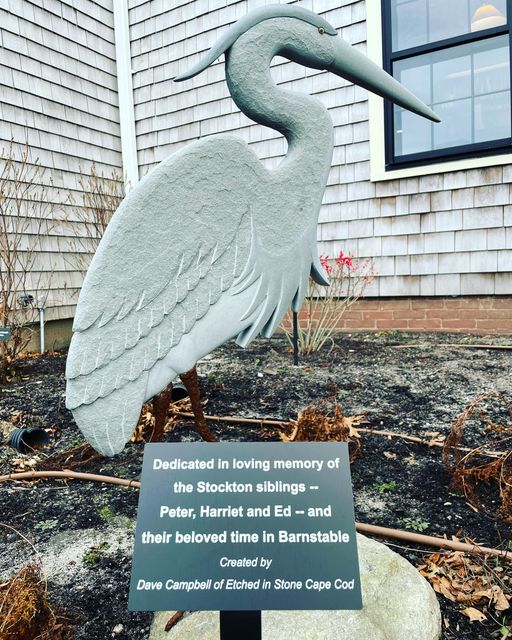2022: In the spring of 2022, we worked again with Dave Scandurra and the crew of Edible Landscapes to revive three of the Library’s gardens. In keeping with our goal of creating educational, sustainable gardens with native and edible plantings, we started with the garden in front of the Library. It had been neglected for a number of years, and consisted of two scraggly boxwoods, old stunted hydrangeas, and an overabundance of bluebells. The old plantings were dug up, the soil amended, and the new plantings went in — bayberry, aronia, inkberry, boneset, and ninebark, accompanied by groundcovers including blue flag iris, native bleeding hearts, wintergreen, hay-scented fern, may apple, foam flower, and more.
A small garden near the rain garden now features gooseberries with a groundcover of native strawberries.
In the garden near the entrance to the Library Dave created a “culinary corner” featuring perennial and annual herbs, as well as hazlenuts, rhubarb, and strawberries.
These gardens were funded by a generous grant from the Rogers Family Foundation, in memory of longtime Barnstable residents Jean and Harry Hilton. We are very grateful for their support of this great project.
Our final garden is a raised bed garden built for us by Gordon Starr, and planted by him, Youth and Adult Services Librarian Christy Munier, and the children who visit Sturgis Library. It features tomatoes, lettuce, beans, marigolds, and a potato barrel. As of this writing the tomatoes are nearly 6 feet tall!
2020/2021: This has been an exciting year for the landscape of Sturgis Library. So many shrubs and flowers and berries and herbs and…oh boy does the list go on. So many new plants have made their way onto the property, it’s hard to count them all. Thanks to several grants from the Mid-Cape Cultural Council, The Association to Preserve Cape Cod, Blue Flax Design, Restore America’s Estuaries, the United States Environmental Protection Agency, and SNEP, we were able to put in a beautiful rain garden by the main entrance and a perennial edible and herbal garden behind the Library. Both of these will function as family-friendly educational gardens for our community.
The purpose of the rain garden is to teach patrons about water conservation, how to garden sustainably, what native plants are available for their own landscaping needs, and how to provide pollinator assistance throughout the year. The rain garden, once it’s established, will be fully sustained by the water that comes off the library’s roof, traversing two downspouts that empty into the garden’s basin. A rain garden is any garden that lies in a depression or ditch that doesn’t require external watering beyond what falls from the sky. Commonly, you will see many native perennial flowers in such a garden, but for ours there is a mixture of flowers (wild columbine, dwarf iris, trailing arbutus) along with a variety of shrubs to provide structure and year-round attraction. Some highlights are the lowbush blueberries, the sweet pepper bush, and the winterberries. The winterberries are particularly beneficial because they provide food for our native birds all throughout winter with the bright red berries that cling to the branches long after all the leaves have fallen. Stop by and take a look to see if you’ll catch a cardinal snacking on these special treats.
Our perennial edible and herbal garden was designed and installed by Edible Landscapes of Cape Cod to educate patrons on exactly what the title suggests…plants that are either perennial and herbal or plants that are perennial and edible. The concept is wonderful, speaking to the idea of a functional landscape that provides homeowners with both food and ingredients for tea and other herbal remedies, along with attracting beneficial fauna to their yards. (What songbird doesn’t love a good Poke Berry?) This garden lives atop the new stonewall curving around the back property line. Patrons can see a wide variety of both native and non-native species of plants ranging from raspberries to bee balm to mountain mint, spikenard, wintergreen, and so much more. While we don’t advise/permit our patrons to harvest any of the plants in the garden (please don’t…some plants only have specific parts that are edible, while other parts might be toxic…), we hope they will have some fresh ideas for what to grow come spring in their own gardens.
Each of the gardens contain a number of botanical signs denoting the genus and species of each plant along with their common names. We just installed a large sign overviewing the qualities and educational aspects of rain gardens near the patio pathway. We hope these will act as tour guides for inquisitive minds, leading patrons through each, opening their eyes to the wide variety of plants they may never have known existed, some of which might thrive on their own property.

Finally, we can’t forget the beautiful bluestone blue heron statue created by Dave Campbell of Etched In Stone Cape Cod. This statue was made possible by a generous donation from the Stockton family in memory of the three siblings, Peter, Harriet and Ed, and their beloved time in Barnstable. Our heron watches over the rain garden, perched among the “lady in red” ferns and fothergilla, waiting for our next rainstorm to wet his talons.
If you haven’t had time to check out our new gardens, feel free to peruse whenever you like. The colder months will be very quiet for both, but come spring, expect to see a wonderful amount of new growth as both gardens begin to fill in and mature, providing color through out three seasons.
Happy gardening!
–Corey Farrenkopf, Assistant Director